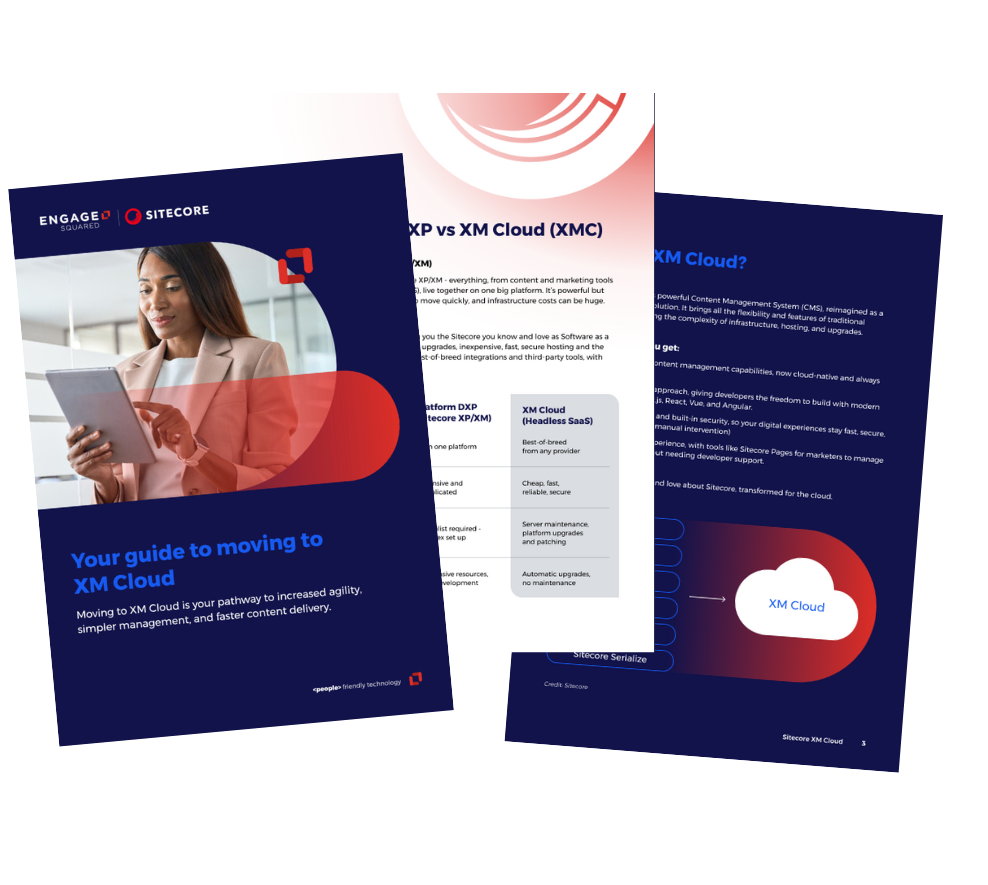
Published 25 July 2025
In this blog, Sitecore guru Bruce Davis-Goff delves into why migrating a multi-lingual, multi-site application from a rigid, tightly coupled CMS to a headless MACH architecture such as Sitecore XM Cloud , isn’t just an upgrade, it’s a profound strategic shift that unlocks unprecedented flexibility, efficiency, and global reach.
In today’s hyper-connected world, digital experiences are no longer confined to a single website. Customers interact with brands across a multitude of channels, from mobile apps and smart devices to in-store kiosks and voice assistants. For businesses managing complex, multi-lingual, multi-site digital presences, the traditional monolithic content management system (CMS) has become a bottleneck, stifling innovation, scalability, and speed to market.
The future, unequivocally, lies in a composable, agile approach: the MACH architecture, with a headless CMS such as Sitecore XM Cloud leading the charge.
The Shackles of the Monolith: A Brief History of the All-In-One
For years, traditional CMS platforms such as Sitecore XP served as the backbone of digital operations. They bundled content management, presentation, and often business logic into a single, tightly coupled system.
While seemingly convenient at first, this monolithic structure presented significant limitations, especially for complex global enterprises:
- Vendor lock-in: Being tied to a single vendor’s ecosystem meant limited choices for best-of-breed tools and slow adoption of new technologies.
- Scalability challenges: Scaling specific components (like Sitecore content delivery servers) often required scaling the entire system, leading to inefficient resource allocation and increased costs.
- Omnichannel headaches: Delivering consistent content across multiple channels (web, mobile, IoT, etc.) was a constant struggle, often requiring duplicated efforts or complex, brittle integrations. Each new channel demanded significant re-engineering of the presentation layer.
- Slow innovation cycles: Any significant change or feature addition necessitated a full-stack deployment, slowing down development cycles and time to market. Updates often meant dreaded, disruptive “big bang” upgrades.
- Developer frustration: Front-end developers were often constrained by the CMS’s templating language and limited in their choice of modern frameworks.
For multi-lingual and multi-site projects, these issues were amplified. Managing translations, regional variations, and distinct site experiences within a single, rigid system became a labyrinth of complexity, leading to content silos, inconsistencies, laborious workflows and mounting costs.
Enter MACH: The Architecture of Agility
The answer to these challenges lies in the MACH architecture:
- Microservices: Instead of one giant application, functionality is broken down into small, independent, and self-contained services. Each service (e.g. content, e-commerce, search, authentication) can be developed, deployed, and scaled independently.
- API-first: All functionality and content are exposed via APIs (Application Programming Interfaces). This ensures seamless communication between different services and allows any front-end application to consume data.
- Cloud-native: The architecture is designed for the cloud, leveraging the scalability, elasticity, and resilience of cloud infrastructure (like Microsoft Azure). This means automatic scaling, continuous delivery, and reduced operational overhead.
- Headless: The content management backend (where content is created and stored) is completely decoupled from the front-end presentation layer (where content is displayed). Content is delivered as raw data via APIs, giving developers complete freedom over the user experience across any device or channel.
This composable approach allows businesses to select best-of-breed solutions for each specific need, rather than being forced into a single, often compromised, suite.
The Headless CMS: The Heart of Your Modern Content Strategy
Within the MACH ecosystem, a headless CMS such as Sitecore XM Cloud plays a pivotal role. Unlike traditional systems, a headless CMS isn’t concerned with how your content looks, but what your content is. It acts as a central content hub, providing structured content that can be pulled and presented by any front-end application.
Here’s how a headless CMS seamlessly integrates into a MACH architecture and addresses the unique demands of multi-lingual, multi-site projects:
- True headless foundation: Built from the ground up with robust Content Delivery and Management APIs, headless CMS platforms empower developers to fetch and manage content programmatically. This decoupling liberates front-end teams to use modern frameworks like React, Vue, Angular, Next.js, or Gatsby on Azure App Services, enabling rapid development and highly optimised experiences.
- Unparalleled content modelling: Flexible content modelling is a game-changer. Instead of rigid templates, you define custom content types (e.g. “Product”, “Blog Post”, “Location”) and fields (text, rich text, images, references). This structured approach ensures content is reusable and adaptable across channels and regional variants.
- Sophisticated localisation and internationalisation: Headless CMS platforms typically support robust localisation features, making it easy to manage content in multiple languages and regions. Fallback locales, selective translation, and country-specific variations reduce complexity and avoid duplicated effort.
- Developer empowerment and integrations: The API-first nature makes headless CMS platforms highly extensible. With SDKs, open documentation, and active ecosystems, developers can integrate with personalisation engines, e-commerce tools, and analytics platforms with ease, all while deploying performant, scalable front ends via Azure.
- Cloud-native and scalable by design: Delivered as SaaS, headless CMS platforms handle scaling, updates, and security, letting teams focus on content and experience delivery, without worrying about underlying infrastructure.
The Migration Journey: From VM Collections to Azure App Services with Your Headless CMS
Moving a complex multi-lingual, multi-site application from a collection of virtual machines with a traditional CMS to Azure App Services with a headless CMS is a strategic undertaking, often involving a parallel upgrade of existing functionalities. Here’s a high-level view of the journey:
Strategic Planning & Discovery:
- Content Audit: Understand existing content, its structure, dependencies, and usage across all sites and languages.
- Content Model Definition: This is crucial. Design content models for your chosen headless CMS that represent your content in a structured, reusable, and future-proof way. This requires collaboration between content strategists, developers, and designers.
- Microservices Identification: Identify existing functionalities that can be refactored into independent microservices (e.g. product catalogue, user profiles, search) to run on Azure App Services or other Azure services (Azure Functions, Azure Kubernetes Service).
- Front-end Strategy: Decide on the modern front-end frameworks (e.g. Next.js, Nuxt.js) that will consume content from your headless CMS and be hosted on Azure App Services.
Content Migration:
- Data extraction & cleansing: Extract content from the old CMS, clean up inconsistencies, and transform it to fit the new headless CMS content models. This is often an iterative process.
- Import into Headless CMS: Utilise the headless CMS’s Management API or migration tools to programmatically import content. For multi-lingual content, careful mapping to the headless CMS’s localisation features is essential.
Application re-platforming & upgrade:
- Refactor/rebuild front ends: Develop new front-end applications that interact exclusively with the headless CMS’s APIs for content and other microservices for business logic. These applications will be deployed to Azure App Services for scalability and ease of management.
- Develop microservices: Build or migrate identified microservices to leverage Azure services. Azure App Services are excellent for hosting web APIs and backend services, while Azure Functions can handle serverless tasks.
- Integration layer: Implement robust API gateways and orchestration layers on Azure to manage communication between the new front ends, your headless CMS, and various microservices.
- Upgrade existing features: During this re-platforming, legacy features can be upgraded or rewritten to take advantage of modern patterns and Azure capabilities.
Deployment & optimisation on Azure app services:
- CI/CD pipelines: Implement Continuous Integration/Continuous Deployment (CI/CD) pipelines using Azure DevOps or GitHub Actions to automate the deployment of your front-end applications and microservices to Azure App Services. This ensures rapid, consistent, and reliable releases.
- Scalability & performance tuning: Leverage Azure App Services’ auto-scaling, regional deployment capabilities, and integration with Azure CDN for optimal performance – especially critical for a global, multi-site presence.
- Monitoring & analytics: Implement comprehensive monitoring (Azure Monitor, Application Insights) to track performance, user behaviour, and content effectiveness across all sites and languages.
The Unlocked Potential
The strategic move to a headless MACH architecture with a headless CMS on Azure App Services offers a wealth of benefits:
- Accelerated time-to-market: Rapid iteration and deployment of new features, campaigns, and even entire new sites or channels. Content changes can go live instantly across all touchpoints.
- True omnichannel presence: Deliver truly consistent and tailored experiences across any current or future digital channel, from web to mobile to IoT.
- Unrivalled scalability: Individually scale content delivery via your headless CMS, and application logic/presentation via Azure App Services, meeting demand spikes efficiently.
- Enhanced developer experience: Empower developers with freedom of technology choice and modern toolchains, leading to faster development and higher quality code.
- Future-proof architecture: The composable nature allows for easy swapping out of components as technology evolves, avoiding future re-platforming nightmares.
- Streamlined global operations: Centralised content management within your headless CMS, with robust localisation features, vastly simplifies the management of complex multi-lingual, multi-site content.
Final thoughts:
Modernising your CMS from a monolithic platform to a headless, composable architecture isn’t just a technical upgrade, it’s a strategic move. For organisations managing multi-lingual, multi-site digital experiences, it’s a chance to break free from rigid legacy systems and embrace a future that’s faster, more flexible, and built for scale. By adopting MACH principles and a modern headless CMS like Sitecore XM Cloud, businesses can simplify content operations, reduce infrastructure burden, and deliver consistent, high-quality experiences to global audiences. The monolithic era is behind us. The future is composable and Sitecore XM Cloud is leading the way.
If you’re starting to rethink your CMS, downloading our Sitecore XM Cloud eBook below is a good place to start. In this guide, we’ll walk through why so many teams are making the move, what XM Cloud has to offer, and what you can expect if you decide to take the next step.
About the author
Bruce Davis-Goff is a Sitecore MVP and is Engage Squared’s Sitecore Practice Lead. He is a previous Sitecore employee and winner of the prestigious Sitecore MVP trophy for 6 years running (2017 – 2023). Bruce is passionate about all things tech and brings a wealth of knowledge and experience to our practice. So, whether it’s a rebuild, migration, reskin, or move to Sitecore XM Cloud, we have you covered with the team to make it happen.





